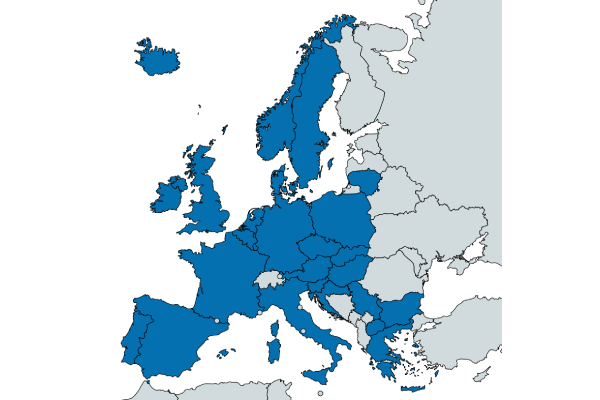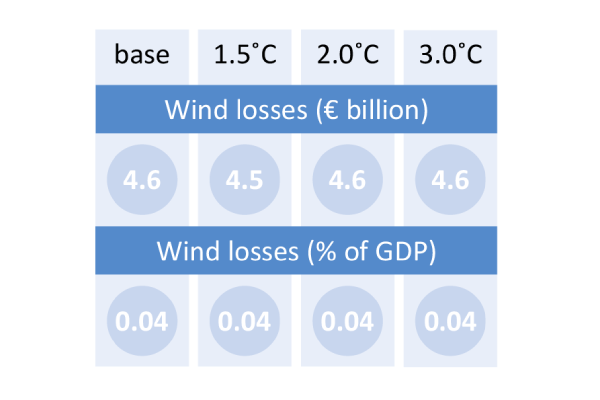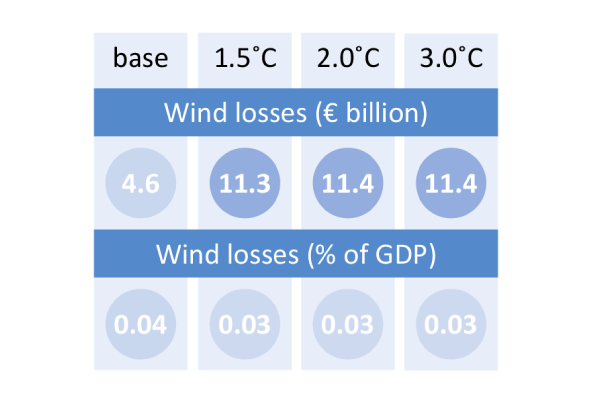
Extreme weather
Europe is grappling with an extreme weather crisis due to the increase in frequency and extent of heatwaves, windstorms and heavy precipitations.
Europe faces a variety of different extreme weather risks, from storms and hurricanes to heatwaves and snowstorms. These weather events are occurring more regularly and becoming more severe, with significant human and economic consequences.


Windstorms are characterised by continuous strong winds and are often accompanied by intense precipitation and may lead to floods, storm surges and coastal erosion.
Heatwaves and extreme temperatures are often connected to droughts, as dry soil reduces evaporative cooling and thus increases the scale of a heatwave. Heatwaves can also worsen droughts as they exacerbate soil moisture deficits and low flows in rivers
Heavy precipitation (snow, snowstorms, hail, rain) events occur both in summer and winter. Hail events in particular are among the most costly weather-related extreme events in several European regions, causing substantial damage to crops, vehicles, buildings and other infrastructure.
Heatwaves in particular are expected to happen more frequently and become more intense. The 2020 PESETA IV study indicates that nearly 300 million people in the EU will be exposed to deadly heatwaves each year, resulting in a 30-fold rise in deaths from extreme heat.
Recent research states that all EU capital cities will become more vulnerable to extreme heat in the coming decades. The cold wave hazard may remain a significant threat locally in certain regions.
The NatCatSERVICE database reports that extreme weather events led to economic losses of EUR 426 billion in the EU between 1980 and 2017, with storms alone causing EUR 163 billion in damages.
Climate change is the main risk driver when analysing extreme weather in Europe. It has already started to increase the severity and frequency of extreme weather events, and this trend is projected to increase.
Most European countries are affected by a range of extreme weather events, from very low temperatures that lead to rainfall, snowfall and cyclones, to extremely high temperatures that lead to heatwaves, droughts and hailstorms. Overall, heatwaves pose the greatest risk to the continent.
As the planet continues to warm, Europe will be affected by more frequent and longer periods of extreme high temperatures.
The PESETA IV report on climate change impacts and adaptation in Europe estimates that southern Europe may experience heatwaves almost every year, and all EU capital cities will become more vulnerable to extreme heat in the coming decades.
Although climate change is a significant driver, infrastructure and built environments not adapted to face extreme temperatures could worsen the impact of heatwaves. According to the European Environment Agency (EEA), this will affect cities in central and north-western Europe the most.

The continued trend of population aging could also exacerbate the effects of heatwaves, as elderly and vulnerable people with chronic diseases have a heightened risk of heat-related death.
The climate in Europe varies from maritime to polar and can be split into four main groups: subtropical, temperate, cold and circumpolar.
The continued trend of population aging could also exacerbate the effects of heatwaves, as elderly and vulnerable people with chronic diseases have a heightened risk of heat-related death.
Largely based on national disaster risk assessments for EU Member and Civil Protection Mechanism Participating States, the ‘Overview of natural and man-made disaster risks the European Union may face’ aims to foster better understanding of disaster risks facing Europe.
The majority of Member States considered the effects of extreme weather and often-covered impacts on critical infrastructure in their risk assessments, including disruption to transport, electricity, sewage and water networks. Secondary hazards, such as flooding, epidemics, chemical contamination, pests in forests and landslides, were also highlighted.
Europe experienced extreme heatwaves in 2017, 2018 and 2019 with data indicating that they may have caused hundreds of premature deaths. The French Ministry of Health reported 1 435 deaths linked to the 2019 summer heatwave, while the National Statistics Bureau of the Netherlands estimated that 2019 heatwaves caused nearly 400 premature deaths.
France, Italy and Greece were affected by extreme weather in November 2019. In Italy, heavy rain, strong winds, storm surges and snow caused river overflow, snow avalanches, flooding and landslides. In addition, roads and highways were damaged and one bridge collapsed following a mudslide.
These trends show that over the next decades, Europe will face worsening impacts due to extreme weather. In southern Europe, an increase in extreme heat, water scarcity, drought and wildfires is forecasted. Northern Europe is expected to experience reduced ice cover and increased temperatures, rainfalls and floods.
The increase and frequency of heatwaves will lead to a greater number of people being exposed to extreme heat and will affect mortality rates. The 2020 PESETA IV report projects that France, Italy and Spain will face the highest number of fatalities.


The EU Adaptation Strategy calls for building stronger links between climate change adaptation and disaster risk reduction.
The new Biodiversity strategy for 2030 contains specific actions and commitments to protect nature and reverse the degradation of ecosystems in the EU, putting Europe's biodiversity on a path to recovery by 2030.
Among the many reports on this topic, two in particular are to be mentioned:
The European Regional Development Fund and Cohesion Fund provide significant funds for investments in preventing and preparing for extreme weather in Member States.
The European Agricultural Fund for Rural Development (EAFRD) implements the common agricultural policy and provides financial support to farmers to restore agricultural production that has been damaged and aims to introduce preventative measures designed to reduce the impact of extreme weather.
Under the ‘Climate change adaptation action’, the LIFE programme provides grants for best practice, pilot and demonstration projects that contribute to increased resilience to climate change.
The Windstorm Information Service (WISC) is a tool that aims to improve the risk and loss assessment of windstorms. Developed by the European Commission’s Copernicus Climate Change Service, WISC can access a high-quality dataset of windstorm information within Europe.
The impact of future extreme weather events will depend on a variety of factors, including levels of development, and implementation of EU actions on climate change and mitigation measures.
The main objective of the EU Solidarity Fund (EUSF) is to alleviate the financial pressure on national authorities by giving aid in the event of a major natural disaster. Member States can request aid from the EUSF in the aftermath of a national disaster and the amount of aid is calculated based on several factors. The EUSF is therefore a valuable and relevant resource in the event of extreme weather.
EU policy and legislative context | Relevant stakeholders and instruments | Additional information |
Regulation (EU) 2018/1999 the Governance of the Energy Union and Climate Action | Ranking European capitals by exposure to heat waves and cold waves | |
Climate change adaptation and disaster risk reduction in Europe |